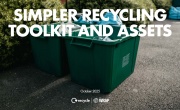UK makes interim waste ETS monitoring voluntary while seeking LA cost solutions
Timeline for carbon allowance obligations becomes uncertain as government develops polluter-pays mechanisms to shield councils from £6.5bn cumulative costs to 2036
 Monitoring requirements for waste facilities due to enter the UK Emissions Trading Scheme will now be voluntary from next year.
Monitoring requirements for waste facilities due to enter the UK Emissions Trading Scheme will now be voluntary from next year.
In a consultation response published yesterday (21 July), the UK Government and devolved administrations also signalled that carbon allowance obligations may be delayed beyond the original 2028 target as policymakers develop mechanisms to protect local authorities from bearing the costs.
The interim Authority Response confirms waste incineration facilities will enter a voluntary Monitoring, Reporting and Verification (MRV) period on 1 January 2026, departing from the government's original consultation which favoured mandatory participation. Notably, no timeline has been confirmed for when facilities will face obligations to purchase and surrender carbon allowances.
This represents a significant policy shift following concerns that the expansion could cost local authorities £747 million in 2028, rising to £1.1 billion by 2036, according to Local Government Association (LGA) analysis.
The voluntary approach to monitoring now aims to "collect essential data for the UK ETS Authority and enable industry to prepare for cost exposure ahead of a move to full inclusion in the scheme".
The Government now says it is committed to developing policies that "ensure Local Authorities are protected from bearing the full costs and ensure the carbon price is apportioned on all polluters in the waste chain", signalling a move towards implementing the polluter-pays principle more broadly across the waste value chain.
Carbon allowance timeline becomes uncertain
The decision to make the MRV period voluntary represents a compromise between the two options outlined in the May 2024 consultation. However, the government has stopped short of confirming the 2028 target for when waste facilities will face carbon allowance obligations, stating that a second Authority Response will be published "as soon as reasonably practicable" once data from the voluntary period has been assessed.
This marks a significant departure from the consistent 2028 timeline that had been communicated since the UK ETS Authority's July 2023 response. The uncertainty highlights the challenge of developing policies that protect local authorities while maintaining decarbonisation incentives.
Local authority protection mechanisms under development
The interim response acknowledges the scale of concern from local authorities, who manage 14.3 million tonnes of residual waste annually, much of which is processed through energy-from-waste facilities. Recent LGA survey data found that 93 per cent of councils believe they will not be able to meet additional ETS costs within existing waste and recycling budgets.
The Government's move to protect local authorities represents a shift in approach. Rather than simply passing carbon costs through existing contractual arrangements, policymakers are now developing mechanisms to "incentivise decarbonisation rather than pass costs through the waste chain and on to Local Authorities".
This could involve expanding the packaging Extended Producer Responsibility (pEPR) scheme to cover the additional carbon tax costs created by ETS. While pEPR already requires producers to pay the full disposal costs for their packaging waste, the ETS will create new carbon allowance costs on top of existing disposal fees. As such, producers of fossil-based packaging materials will contribute to covering both existing disposal costs and the additional carbon costs when their products end up in residual waste streams.
Industry response cautiously optimistic
Waste management companies have welcomed the government's recognition of local authority concerns. A Viridor spokesperson said: "We welcome the Government's announcement yesterday on the Emissions Trading Scheme's expansion, which is a strong step forward for the UK's waste sector. Developing and testing carbon factors is vital to drive decarbonisation and ensure waste producers are rewarded for decarbonising their waste. Using the MRV period to test and develop this approach will help ensure an effective full ETS implementation in 2028. The support for the local authorities is very welcome as is policy to prevent waste leakage to landfill or export."
The voluntary monitoring period will allow operators to develop expertise in fossil-biogenic emissions separation without immediate cost exposure. The government confirmed it will pursue "an integrated monitoring approach which will combine Carbon-14 monitoring and emissions factors" to address technical challenges in distinguishing fossil from biogenic emissions.
This approach involves analysing flue gas emissions to identify carbon-14 isotopes, which are present in biogenic waste but absent from fossil-based materials, allowing facilities to determine what proportion of their CO2 emissions should be subject to carbon pricing. Only fossil carbon emissions will face ETS obligations under the scheme
However, the uncertainty over when carbon allowance obligations will begin may create challenges for operators planning decarbonisation investments, including carbon capture and storage technology. The original consultation estimated that waste incineration emissions would require 21.9 million UK Allowances over 2028-2030, equivalent to 21.9 million tonnes of CO2, with 7.9 million tonnes projected for the first year of full participation - figures that may now need revision if the timeline shifts.






